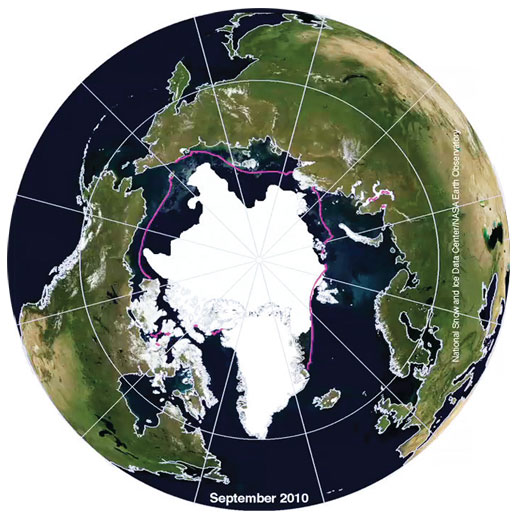
Sea ice extent in Sept. 2010; pink line shows long-term average for the month. NSIDC
Disappearing
acts
Tracking Arctic sea ice loss
The sea ice blanketing much of the Arctic Ocean grows in the winter and shrinks in the summer, hitting a minimum every year around September. In 2010, that minimum was the third lowest since 1979, when the satellite record began, CIRES scientists calculated.
CIRES' National Snow and Ice Data Center (NSIDC) tracks Arctic sea ice extent every year. Although winds and other weather patterns leave more ice some years, less others, the sea ice has declined precipitously overall. The summertime minimum extent has plummeted at a rate of more than 11 percent per decade since 1979, according to NSIDC.
"All indications are that sea ice will continue to decline over the next several decades," said CIRES Fellow Mark Serreze, NSIDC director. "We are looking at a seasonally ice-free Arctic in twenty to thirty years."
In September 2010, Arctic sea ice stretched for only about 1.89 million square miles, less than any other year except 2008 (1.8 million square miles) and 2007 (1.65 million). The long-term average for the month of September (1979-2000) is 2.70 million square miles.
Greenland Ice Sheet losing ice mass from northwest coast
Ice loss from the Greenland Ice Sheet, which has been increasing during the past decade over its southern region, is now moving up its northwest coast, according to an international study published in 2010.
CIRES Fellow John Wahr was among international scientists who studied data from NASA's Gravity and Recovery Climate Experiment satellite system, or GRACE. The team compared GRACE measurements with others made by
global positioning systems affixed to bedrock on the edges of the ice sheet.
On Greenland's northwest coast, the Earth surface rose by 1.5 inches from October 2005 to August 2009, because less ice was pressing down upon it. Although GRACE's resolution is not precise enough to pinpoint the source of the ice loss, the fact that the ice sheet is losing mass nearer to the ice sheet margins suggests the flows of Greenland outlet glaciers there are sliding downhill fast, dumping more ice in the ocean.![]()


